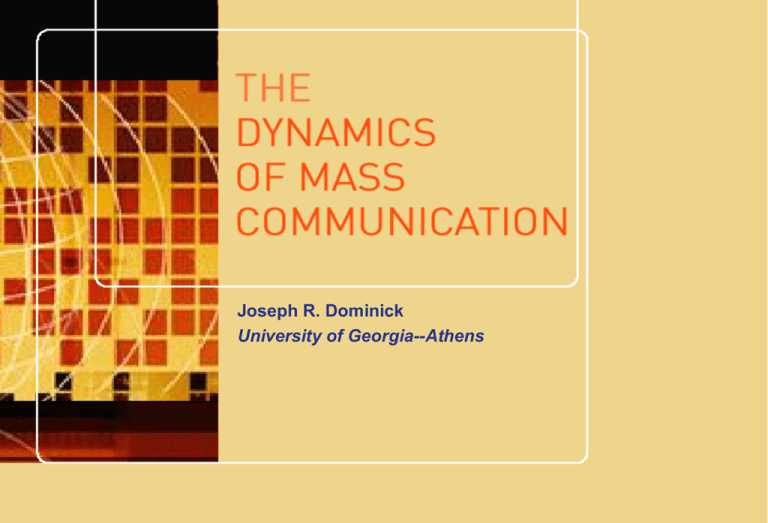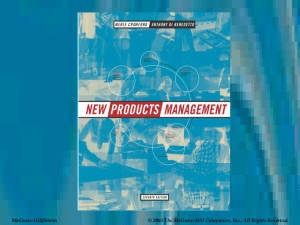
Slide 1
Joseph R. Dominick
University of Georgia--Athens
© 2005 The McGraw-Hill Companies, Inc. All rights reserved.
Slide 2
Part IV
Regulation of the
Mass Media
© 2005 The McGraw-Hill Companies, Inc. All rights reserved.
Slide 3
Chapter 15
Formal
Controls:
Laws,
Rules,
Regulations
Chapter Outline
The Press, the Law, and the Courts
Protecting News Sources
Covering the Courts
A Reporter’s Access to Information
Defamation
Invasion of Privacy
Copyright
Obscenity and Pornography
Regulating Broadcasting
Regulating Cable TV
The Telecommunications Act of 1996
Regulating Advertising
© 2005 The McGraw-Hill Companies, Inc. All rights reserved.
Slide 4
The Press the Law and the Courts
Congress shall make no law respecting an
establishment of religion, or prohibiting the
free exercise thereof; or abridging the
freedom of speech, or of the press, or the
right of the people peaceably to assemble,
and to petition the Government for a redress
of grievances.
– The First Amendment to the Constitution of the United States
© 2005 The McGraw-Hill Companies, Inc. All rights reserved.
Slide 5
The Press the Law and the Courts
Prior Restraint
the government attempts to censor the press
before something is published
Two cases
Near v. Minnesota (1920s)
The Pentagon Papers (1970s)
Secretary McNamara’s study of the Vietnam War
U.S. Attorney Mitchell asks for prior restraint
Newspapers published portions in turns
Supreme Court rules in favor of papers (1971)
© 2005 The McGraw-Hill Companies, Inc. All rights reserved.
Slide 6
Protecting News Sources
The Reporter’s Privilege
Paul Branzburg of the Louisville CourierJournal (1969)
U.S. Supreme Court: 1st Amendment does not
prevent questions about a criminal investigation
Shield laws provide news-source protection
Freelance Vanessa Leggett jailed for 168 days
© 2005 The McGraw-Hill Companies, Inc. All rights reserved.
Slide 7
Protecting News Sources
Search and seizure
an unannounced court-issued warrant to search for
and seize a reporter’s notes
Stanford Daily (1971)
Clash between police and demonstrators
Police with search warrant for photos of incident
Search ruled legal in 1978
Reporters Committee for Freedom of the
Press v. AT&T (1974)
New York Times and Myron Farber (1976)
© 2005 The McGraw-Hill Companies, Inc. All rights reserved.
Slide 8
Covering the Courts
Free Press (1st) vs. Fair Trial (6th)
Publicity before and during a trial
Jury contamination
Case of Dr. Sam Sheppard (1954)
Case of Leslie Irvin (1961)
Supreme Court’s 6 safeguards include
Sequestering the jury
Change of venue
Injunctions against divulging information by
Lawyers
Witnesses
Others
© 2005 The McGraw-Hill Companies, Inc. All rights reserved.
Slide 9
Covering the Courts
Gag Rules
Nebraska Press Association (1976)
1980s: jury selection open to the public
2002-2003: Philadelphia Inquirer’s post-trial
interviews of jury
Cameras and Microphones in the Courtroom
1930s Hauptmann / Lindbergh trial
ABA passes Canon 35 of Code of Professional Ethics
Estes case of 1965
Canon 3A(7) supersedes 35 (1972)
1981 Supreme Court decision
© 2005 The McGraw-Hill Companies, Inc. All rights reserved.
Slide 10
A Reporter’s Access to Information
Freedom of Information Act (1966)
Electronic Freedom of Information Act (1996)
Sunshine Laws
Patriot Act (2001)
Government has more access to email and
telephone records
Easier to restrict access to official records
Press cannot find out about FBI searches of book
buying and borrowing records
© 2005 The McGraw-Hill Companies, Inc. All rights reserved.
Slide 11
Defamation
Defamation law protects a person’s reputation
Libel: Written defamation that tends to injure a
person’s reputation or good name or diminish the
esteem, respect, or goodwill due a person
Slander: Spoken defamation
Libel per se: Automatically libelous expressions
such as “swindler”
Libel per quod: Utterances that are not blatantly
libelous, but libelous nevertheless
© 2005 The McGraw-Hill Companies, Inc. All rights reserved.
Slide 12
Defamation
Proving that you’ve been defamed by the media
1)
2)
3)
4)
You’ve been defamed and harmed by the statements
You have been identified, not necessarily by name
The statements have been published
The media were at fault
Fault or carelessness required
5) What was published or broadcast was false
Burden of proof on the one who sues, if private person
Quoting another is not sufficient defense
© 2005 The McGraw-Hill Companies, Inc. All rights reserved.
Slide 13
Defamation
Three defenses against a libel suit
Truth
If true, no libel
Difficult to prove
Privilege
Public’s right to know takes precedence
Judicial proceedings, arrest warrants, grand jury indictments,
legislative proceedings, public city council sessions
Fair comment and criticism
Invitation of public attention
Opinion and criticism
© 2005 The McGraw-Hill Companies, Inc. All rights reserved.
Slide 14
Defamation
Public Officials and Actual Malice
New York Times v. Sullivan (1964)
Editorial advertising is protected by the 1st
Amendment
Even false statements may be protected if
they concern a public official’s public conduct
Public officials must prove that defamatory
statements were made with actual malice
Actual malice – publishing a statement in
“reckless disregard” or knowing it is false
Firestone divorce in 1976
© 2005 The McGraw-Hill Companies, Inc. All rights reserved.
Slide 15
Defamation
Damages awarded in defamation suits
Actual damages: the amount of money lost as a
result of the defamation
Punitive damages: awarded by juries with the
intent of punishing media behavior
Can be substantial ($20M against NBC)
Must show the media acted with actual malice
Internet defamation
Carrier is not liable
Publisher liable everywhere downloads are possible
© 2005 The McGraw-Hill Companies, Inc. All rights reserved.
Slide 16
Invasion of Privacy
Right to Privacy
Libel laws protect a person's reputation
Libel involves publication of false material
Right of privacy protects a person's peace of
mind and feelings
Invasion of privacy might be triggered by
disclosing the truth.
© 2005 The McGraw-Hill Companies, Inc. All rights reserved.
Slide 17
Invasion of Privacy
Ways in which mass media invade
someone's privacy:
Intruding upon a person's solitude or seclusion
Unauthorized release of private information
Publicizing people in a false light or creating a
false impression of them
Appropriation of a person's name or likeness for
commercial purposes
© 2005 The McGraw-Hill Companies, Inc. All rights reserved.
Slide 18
Invasion of Privacy
Trespass and the Press
Unauthorized entry onto somebody else's territory
No special First Amendment privilege for journalists
Cases include
Reporters entering with permission of a police officer
Reporters accompanying the police into a private home
Reporters following demonstrators onto company property
Reporters accompanying police serving a search warrant
Food Lion v. ABC (1996)
© 2005 The McGraw-Hill Companies, Inc. All rights reserved.
Slide 19
Copyright
Copyright laws protect authors against unfair
appropriation of their work
For works created after January 1978,
copyrights last life of author plus 70 years
Works created before then are protected for a
period of 95 years
Copyright laws protect literary and dramatic
manuscripts, music works, sound recordings,
motion pictures, and TV programs
Not protected are ideas, news, discoveries, or
procedures
© 2005 The McGraw-Hill Companies, Inc. All rights reserved.
Slide 20
Copyright
Fair use means someone can copy work for
teaching, research, news reporting, etc.
Qualifying factors
Purpose of the use (profit vs. non-profit)
Nature of the work
Percentage of work copied
Effect of use on potential market value of
copyrighted work
© 2005 The McGraw-Hill Companies, Inc. All rights reserved.
Slide 21
Copyright
1995: Internet materials covered by copyright laws
1999: Napster sued by recording industry
KaZaA and Grokster take up the Napster torch
Industry sues 250+ individuals
Digital Millennium Copyright Act stipulates that
royalty obligation applies to Internet stations
2002 bill allows stations to negotiate fees with
artists and recording companies
© 2005 The McGraw-Hill Companies, Inc. All rights reserved.
Slide 22
Obscenity and Pornography
Obscenity not protected by 1st Amendment
What is obscene?
Hicklin Rule (1860s): a work is obscene if
isolated passages tend to deprave or corrupt
the mind of the most susceptible person
Roth v. United States (1957)
Average person
Contemporary standards
Dominant theme
Prurient interests
© 2005 The McGraw-Hill Companies, Inc. All rights reserved.
Slide 23
Obscenity and Pornography
Roth proved problematic
Later decisions added
“patently offensive”
“utterly without redeeming social value”
variable obscenity (1969)
© 2005 The McGraw-Hill Companies, Inc. All rights reserved.
Slide 24
Obscenity and Pornography
Miller v. California (1973)
an average person, applying contemporary
community standards, finds the work as a whole
appeals to prurient interest
the work depicts or describes in a patently
offensive way certain sexual conduct that is
specifically spelled out by state law
the whole work lacks serious literary, artistic,
political, or scientific value
© 2005 The McGraw-Hill Companies, Inc. All rights reserved.
Slide 25
Obscenity and Pornography
1988 – Child Protection and Obscenity
Enforcement Act
Specifically mentions computers
1996 – Communications Decency Act
Ruled unconstitutional
Child Online Protection Act
Blocked by appeals court
Children’s Internet Protection Act
Affects libraries that receive federal funds
Ruled constitutional by U.S. Supreme Court (2003)
© 2005 The McGraw-Hill Companies, Inc. All rights reserved.
Slide 26
Regulating Broadcasting
Radio Act of 1927
Airwaves belong to the public
Broadcasters must be licensed
Scarcity of the resource means more regulations
Federal Communications Commission
Doesn’t make laws; interprets them
“…operating within the public interest…”
Children’s Television Act
Requires educational programming
Limits commercial time during children’s programming
© 2005 The McGraw-Hill Companies, Inc. All rights reserved.
Slide 27
Regulating Broadcasting
FCC Punitive Actions
Fine a station up to $250,000
Renew a license on probation, usually a year
Revoke or fail to renew a license
99.8% of all licenses are renewed
© 2005 The McGraw-Hill Companies, Inc. All rights reserved.
Slide 28
Regulating Broadcasting
FCC Issues of Continuing Concern
Indecent content banned between 6 AM and
10 PM
Equal Opportunities Rule
Bona fide candidates for public office
1 min 1 min
x $/min x $/min
Fairness Doctrine
Not currently in force
Broadcasters must present opposing viewpoints
on controversial public matters
© 2005 The McGraw-Hill Companies, Inc. All rights reserved.
Slide 29
Regulating Cable TV
1950s: FCC says it has no say over cable
1960-1972: FCC writes series of regulations
1980s: Almost all regulations dropped
Cable Communications Act of 1984
Operators decide rates and channels
State and local governments grant franchises
© 2005 The McGraw-Hill Companies, Inc. All rights reserved.
Slide 30
Regulating Cable TV
Cable TV Act of 1992
FCC regulates cable fees
Cable must carry broadcast stations
Broadcast can waive right if cable pays them
Cable rates dropped by 17%
Broadcast rights challenged in court
1994/1997: Supreme Court upholds “must carry”
© 2005 The McGraw-Hill Companies, Inc. All rights reserved.
Slide 31
The Telecommunications Act of 1996
No limit on radio stations that can be owned by
one entity, up to 8 in one market
No limit on TV stations that can be owned by one
entity, but less than 35% of nation’s TV homes
Telephone companies can do cable TV
Cable TV companies can do telephone
Deregulation of cable rates
V-chip and ratings system
© 2005 The McGraw-Hill Companies, Inc. All rights reserved.
Slide 32
Regulating Advertising
Deceptive advertising
Until 1900s, caveat emptor
FTC created in 1914 to clean up business practices
1938 Wheeler-Lea Act
FTC enforcement
Trade regulations that suggest guidelines
Consent order – advertiser agrees to stop practice
without admitting wrongdoing
Cease-and-desist order – if company doesn’t comply
at this stage, the FTC can also fine them
© 2005 The McGraw-Hill Companies, Inc. All rights reserved.
Slide 33
Regulating Advertising
Is your commercial speech protected
by the 1st ?
Use the Supreme Court’s
4-part test!
Are
Doesthe
Does
it involve
the
the
state’s
government
state’s
regulations
unlawful
regulation
haveonly
actually
as
activityasor
substantial
advance
broad
the
necessary
advertising
interest
government’s
in
to regulating
promote
that’sinterest?
false
the
or misleading?
the
state’s
speech?
interest?
© 2005 The McGraw-Hill Companies, Inc. All rights reserved.






